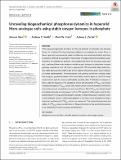Files in this item
Unravelling biogeochemical phosphorus dynamics in hyperarid Mars-analogue soils using stable oxygen isotopes in phosphate
Item metadata
| dc.contributor.author | Shen, Jianxun | |
| dc.contributor.author | Smith, Andrew | |
| dc.contributor.author | Claire, Mark | |
| dc.contributor.author | Zerkle, Aubrey Lea | |
| dc.date.accessioned | 2020-08-21T16:30:21Z | |
| dc.date.available | 2020-08-21T16:30:21Z | |
| dc.date.issued | 2020-11 | |
| dc.identifier | 269272751 | |
| dc.identifier | 15b491c5-e41a-48df-a1da-d584403982d2 | |
| dc.identifier | 85089573257 | |
| dc.identifier | 000561184300001 | |
| dc.identifier.citation | Shen , J , Smith , A , Claire , M & Zerkle , A L 2020 , ' Unravelling biogeochemical phosphorus dynamics in hyperarid Mars-analogue soils using stable oxygen isotopes in phosphate ' , Geobiology , vol. 18 , no. 6 , pp. 760-779 . https://doi.org/10.1111/gbi.12408 | en |
| dc.identifier.issn | 1472-4677 | |
| dc.identifier.other | ORCID: /0000-0001-9518-089X/work/79226860 | |
| dc.identifier.other | ORCID: /0000-0003-2324-1619/work/79226971 | |
| dc.identifier.uri | https://hdl.handle.net/10023/20497 | |
| dc.description | This project has received funding from the European Research Council under the European Union’s Horizon 2020 Research and Innovation Programme (Grant 678812 to M.W.C.). J.S. also acknowledges support from the China Scholarship Council (CSC). | en |
| dc.description.abstract | With annual precipitation less than 20 mm and extreme UV intensity, the Atacama Desert in northern Chile has long been utilized as an analogue for recent Mars. In these hyperarid environments, water and biomass are extremely limited, and thus, it becomes difficult to generate a full picture of biogeochemical phosphate‐water dynamics. To address this problem, we sampled soils from five Atacama study sites and conducted three main analyses—stable oxygen isotopes in phosphate, enzyme pathway predictions, and cell culture experiments. We found that high sedimentation rates decrease the relative size of the organic phosphorus pool, which appears to hinder extremophiles. Phosphoenzyme and pathway prediction analyses imply that inorganic pyrophosphatase is the most likely catalytic agent to cycle P in these environments, and this process will rapidly overtake other P utilization strategies. In these soils, the biogenic δ18O signatures of the soil phosphate (δ18OPO4) can slowly overprint lithogenic δ18OPO4 values over a timescale of tens to hundreds of millions of years when annual precipitation is more than 10 mm. The δ18OPO4 of calcium‐bound phosphate minerals seems to preserve the δ18O signature of the water used for biogeochemical P cycling, pointing toward sporadic rainfall and gypsum hydration water as key moisture sources. Where precipitation is less than 2 mm, biological cycling is restricted and bedrock δ18OPO4 values are preserved. This study demonstrates the utility of δ18OPO4 values as indicative of biogeochemical cycling and hydrodynamics in an extremely dry Mars‐analogue environment. | |
| dc.format.extent | 20 | |
| dc.format.extent | 2672604 | |
| dc.language.iso | eng | |
| dc.relation.ispartof | Geobiology | en |
| dc.subject | Biosignature | en |
| dc.subject | Hyperarid | en |
| dc.subject | Mars | en |
| dc.subject | Metabolic pathway | en |
| dc.subject | Phosphate | en |
| dc.subject | Stable oxygen isotope | en |
| dc.subject | GE Environmental Sciences | en |
| dc.subject | DAS | en |
| dc.subject.lcc | GE | en |
| dc.title | Unravelling biogeochemical phosphorus dynamics in hyperarid Mars-analogue soils using stable oxygen isotopes in phosphate | en |
| dc.type | Journal article | en |
| dc.contributor.sponsor | European Research Council | en |
| dc.contributor.institution | University of St Andrews. School of Earth & Environmental Sciences | en |
| dc.contributor.institution | University of St Andrews. St Andrews Centre for Exoplanet Science | en |
| dc.contributor.institution | University of St Andrews. St Andrews Isotope Geochemistry | en |
| dc.identifier.doi | 10.1111/gbi.12408 | |
| dc.description.status | Peer reviewed | en |
| dc.identifier.grantnumber | 678812 | en |
This item appears in the following Collection(s)
Items in the St Andrews Research Repository are protected by copyright, with all rights reserved, unless otherwise indicated.

